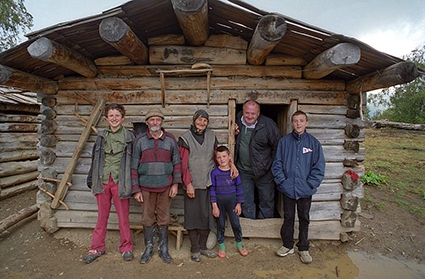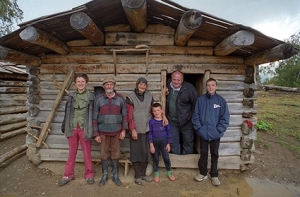Made in Svaneti
We found some local guys to work on the next stage of our garage project: getting the roof on. Watching the process, its four walls built by my wife’s father and brother-in-law last year, has got me thinking about the number of things that Svans know how to make or do by hand, here in their splendid but sometimes challenging isolation.
They were making four armature sets to go between the tops of the walls and the bottom of the roof, one per wall, square in cross-section. The materials were steel rebar and wire; but first they had to make a couple of little factories to assemble these pieces. One was a set of nails in a thick piece of wood, for bending thick wire into squares the size of the cross-section; eighty of these squares were needed. Then, for each armature, four lengths of rebar, separated by the wire squares and joined to them by thinner wire. This assembly factory they built from... nothing, scraps of wood really, fixed to the back fence.
The way these two men worked, quickly and without a fuss, showed me that they knew exactly what they were doing, likely from years or decades of experience. Knowledge as esoteric and foreign to me as magic, really (though I’m sure I know things that they don’t).
They also sawed and hammered more scrap wood into some intriguing corner-triangle shapes, the function of which I would never have been able to guess at. These were parts of the scaffold which must surround the garage. Each was held to part of a wall by a diagonal beam which they dug into the ground; beam, triangle and wall were not fixed to each other at all, merely held in place by gravity. They then nailed some planks horizontally into place on which to walk.
Rebar armatures hoisted into place, they next had to nail more sets of planks together outside and inside the walls. These functioned as the moulds into which they would pour the concrete. Only then were they ready to mix the stuff, haul it up bucket by bucket, and pour it in, covering the armatures and acting as a “belt” of strength and support for the coming roof. Now, we wait for two more of the many sunny days with which September has graced us, and then they’ll be back to assemble the roof and haul it into place, section by section. I’m sure that this too will give me its own set of further revelations about how clever Svans are with their hands and eyes.
Follows a list of other things made or used up here.
The unique Svan hat, a skull cap made of thick sheep’s wool felt which may be black, white, gray or brown. And the wooden mould on which it is shaped. (They’re starting to experiment with ladies’ hats too, these being larger, brimmed and much more colorful.)
Screens for sifting river-sand to a consistency useful in cement-making. The main thing recycled for these is an old steel bed-frame with its diagonal “spring set” which I otherwise find useless in its original purpose. Much better as a sand sieve than as a thing to try to sleep on!
Drill bits from nails.
Doors and window frames from wood. All of the former, huge and thick, we knocked out of the house and replaced with modern double-glazed ones, as they were starting to get worm-eaten after ten years of abandonment before we bought the house. They have starred in some of the above construction details, however. The latter are marvels of multi-piece joinery, which I’m told would fetch pretty prices as handmade doors in a place like America, languishing in nostalgia and too rich for its own good.
Sleds (with or without wheels), from naturally wind-bent logs of the right shape, for oxen to haul wood or hay on year-round. The wheel arrived here late, it seems, but progress was not delayed by this.
The towers themselves, the towers... so tall and straight, with walls so thick and foundations so deep that one can only marvel: A thousand years ago or more? With no electricity or heavy machinery such as cranes to haul those huge stones into place? The mortar too, lasting all this time? The massively heavy slate roofs? Every inch a marvel, every one of them, more so in this harsh, long-wintered climate.
Beehives, from start to finish, each needing to be a precisely engineered wooden box with many parts, a city for many thousands of bees to live in regardless how hot or cold it gets.
Millstones for grinding flour, powered by river water, and the whole mill. Less used nowadays as pre-ground flour is much easier to obtain than it used to be.
Door locks and gate latches. How do they get these things to work so easily? I stand amazed and frustrated at my own poor efforts in this department.
When the going was tough (most of their history), the Svans rose to meet it, literally carving out a life for themselves before modernity came to make life so much easier. Much of what they accomplished they still can. Kudos to them.
Tony Hanmer runs the “Svaneti Renaissance” Facebook group, now with over 1200 members, at
www.facebook.com/groups/SvanetiRenaissance/
He and his wife also run their own guest house in Etseri:
www.facebook.com/hanmer.house.svaneti
Tony Hanmer












